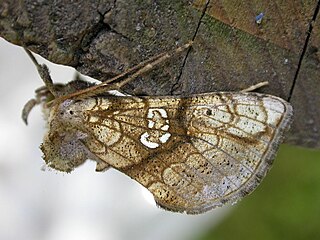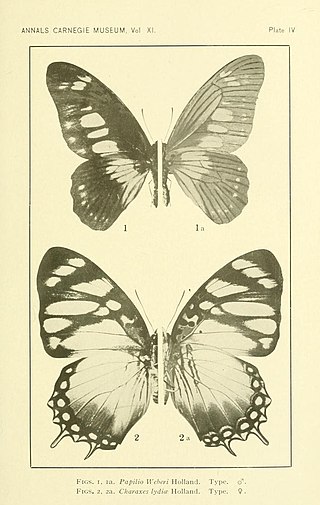
The red underwing is a moth of the family Erebidae. The species was first described by Carl Linnaeus in his 1767 12th edition of Systema Naturae.

Anthene emolus, the ciliate blue, is a small butterfly found in India and southeast Asia that belongs to the lycaenids or blues family. The species was first described by Jean-Baptiste Godart in 1823.

Nacaduba hermus, the pale four-line blue, is a species of lycaenid butterfly found in Indomalayan realm. The species was first described by Baron Cajetan von Felder in 1860.

Mormo maura, the old lady or black underwing, is a species of moth of the family Noctuidae. The species was first described by Carl Linnaeus in the 10th edition of his Systema Naturae. It is found in the Palearctic realm, from north-western Africa through all over southern Europe. It reaches its northern border in the west in northern Ireland and central Scotland, in central Europe, in northern Germany and Poland. In some Nordic countries, there are single finds. The other occurrence areas include Turkestan, Anatolia, the Middle East and Iraq. The name "old lady" refers to the fact that the wing pattern was said to resemble the shawls worn by elderly Victorian ladies.

Dysgonia algira, the passenger, is a moth of the family Noctuidae. The species was first described by Carl Linnaeus in 1767 and is found in the Palearctic - from the southern half of Europe and parts of North Africa through West, Central and South Asia.

Helotropha leucostigma, the crescent, formerly Celaena leucostigma is a moth of the family Noctuidae. It is found in the Palearctic realm.

Xanthia gilvago, the dusky-lemon sallow, is a moth of the family Noctuidae. The species was first described by Michael Denis and Ignaz Schiffermüller in 1775. It is found in Europe.

Polychrysia moneta, the golden plusia, is a moth of the family Noctuidae. It is found in the Palearctic realm.

Catocala electa, the rosy underwing, is a moth of the family Erebidae. The species was first described by Karl Friedrich Vieweg in 1790. It can be found in Europe and Asia.

Catocala nymphagoga, the oak yellow underwing, is a moth of the family Erebidae. It is found in Southern Europe, from Bulgaria up to the Iberian Peninsula and sometimes further north as a migrant. It is also found in North Africa and Asia Minor.

Mesapamea secalis, the common rustic, is a moth of the family Noctuidae. The species was first described by Carl Linnaeus in his 1758 10th edition of Systema Naturae. It is found in Europe, north-west Africa, Turkey and northern Iran.

Grammodes stolida, the geometrician, is a moth of the family Erebidae. The species was first described by Johan Christian Fabricius in 1775. It is found in Africa, southern Europe, most of Asia and Australia. It migrates to central and northern Europe as far north as England, Denmark and Finland.

Nycteola revayana, the oak nycteoline, is a moth of the family Nolidae. The species was first described by Giovanni Antonio Scopoli in 1772. It is found from Europe and east across the Palearctic to Japan and India.

Charaxes lydiae is a butterfly in the family Nymphalidae. It is found in Cameroon, Gabon and the Republic of the Congo.

Elaphria venustula is a moth of the family Noctuidae. It is found in most of Europe, except the north. In the east, the range extends through the Palearctic to the Pacific Ocean.
Lophocampa indistincta is a moth of the family Erebidae. It was described by William Barnes and James Halliday McDunnough in 1910. It is found in California, where it is only found on the Channel Islands.
Udea berberalis is a moth in the family Crambidae. It was described by William Barnes and James Halliday McDunnough in 1918. It is found in North America, where it has been recorded from California.
Udea rusticalis is a moth in the family Crambidae. It was described by William Barnes and James Halliday McDunnough in 1914. It is found in North America, where it has been recorded from Arizona.
Habrona concinna is a moth in the family Drepanidae. It is found in Papua and Papua New Guinea, where it has been recorded from mountainous areas.
Habrona marmorata is a moth in the family Drepanidae. It is widely distributed in Papua and Papua New Guinea.














